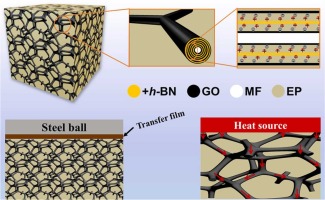Abstract
Improving thermal conductivity is critical for tribological performance but remains a challenge. Here, a 3D structure with layered features is fabricated by electrostatic assembly of h- BN and GO nanosheets. The strategy for structural adjustment from macro to microscopic is beneficial for efficient phonon transport by reducing interfacial thermal resistance, which in turn promotes friction-reduction and wear resistance performance based on "synergistic lubrication". The superiority of the strategy is directly reflected in the excellent self-lubricating, wear-resistance properties, and outstanding thermal conductivity enhancement (1039.16 %) of the composite. Significantly, the comprehensive properties of epoxy-based composites are closely related to macro-and microgeometry of GO and h-BN, helping to reveal the relation between the structural design of multicomponent 2D fillers and tribology-based multifunctionality.

Keywords:Graphene oxideh-BNElectrostatic functionalization3D structure
Published in TRIBOLOGY INTERNATIONAL Volume176;10.1016/j.triboint.2022.107918,DEC 2022


